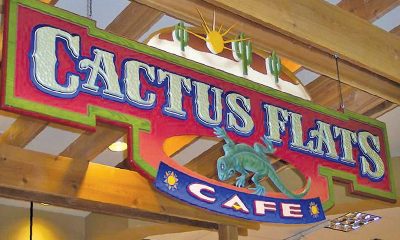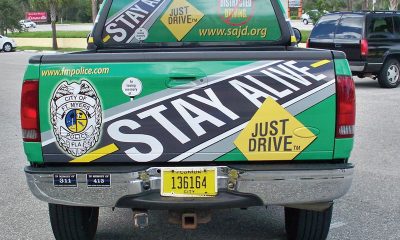You’ve got to accentuate the positive
Eliminate the negative
Latch on to the affirmative
Don’t mess with Mister In-Between
(Lyrics by Johnny Mercer, 1944, recorded by Bing Crosby and the Andrews Sisters, 1944 )
A great offense is better than a great defense. Instead of countering unfounded negatives, why doesn’t the sign industry expound on the benefits of signage?
Here are some great examples that prove signs’ value.
Signtronix (Torrance, CA) gives rebates to its sign-buying customers if they ask their first-time customers how they heard about their business. Currently, over a 14-year period, 46% of these 13,040 first-time patrons say they’d heard about the retailer in question because of its on-premise sign. Other possible responses were “word of mouth,” (37%) and “Yellow Pages,” “newspaper,” “radio” and “television,” all at less than 10%.
Advertisement
• In 1997, a downtown Cincinnati nightclub called Caddy’s was razed to make room for the Cincinnati Bengals’ new Paul Brown Stadium. Hamilton County offered $1.3 million in compensation. Ideally located where I-75 and I-71 join, the site received more than six million exposures per month. The club used entire walls as signs, a total of 2,500 sq. ft. Thanks to Kevin Holthaus’ testimony, Caddy’s owners received an additional $1.8 million because of the advertising value of the signage (February 1998 ST).
• Licensed appraiser Richard Bass wrote (March 1996 ST) about a Shulman’s drugstore inside a Sarasota, FL, mall that lost its pole sign when a TGI Friday’s moved in, due to a sign-code limit of three pole signs. The $3,500 sign was worth $250,000 in sales; store sales reached more than $5 million annually. Without the sign, the drugstore was forced to close its doors. The mall lost $1 million in income. Food-court sales dropped 30%. Six other stores closed. Sarasota lost $18,000 in sales-tax revenue. Two dozen people lost their jobs.
• At the 2003 Retail Exposition, restaurateur Mike Shotzbarger said two of his restaurants should average $3 million in sales. A TGI Friday’s in Long Beach, CA, however, achieved sales of more than $4 million. Shotzbarger attributed it to the sign, which had more than 1.5 million monthly exposures. In contrast, a Bamboo Club restaurant in Scottsdale, AZ, similarly expected $3 million in annual sales. Yet it only achieved $2.2 million, because the local sign code didn’t allow street signage.
• The Signage Sourcebook (2003) includes a section that calculates the CPM (cost per thousand impressions) for various media, based on the gross number of exposures. The results are: Television, $13.20; Radio, $6.47; Newspaper, $3.47; Outdoor advertising, $1.65; and On-premise sign, $0.40.
• Richard Bass also wrote about a Rodeway Inn in Lake City, FL. With its pole sign, which had I-75 visibility, the motel had 86% occupancy, gross sales of more than $600,000, and a profit of $128,000. The state route on which it was located was widened, and the Florida DOT took away the sign. The FDOT appraiser valued the sign at $7,000, based solely on its structure. The next year, occupancy fell to 42%; gross income dropped to $350,000, and profit plummeted 69% to $40,000. FDOT was faced with paying more than $400,000 for the taking, or paying $90,000 for a replacement sign. It chose the latter.
• 3M studied the effects of Denny’s restaurants’ first manual, changeable-copy readerboard in 1972. During a two-week period, 1,942 customers were interviewed. The special feature listed on the Wagner Zip-Change readerboard showed an 87% increase in sales. One of every six customers said the readerboard influenced their decision to eat at Denny’s.
Advertisement
• When a Days Inn lost use of a neighboring, highway-visible EMC in 1990, the new owner wanted Days Inn to pay for continued usage. By three different valuation methods – comparable sales, income and cost – the value ranged between $1.2 and $1.6 million (April 1989 ST).
• When a lessor failed to have two on-premise signs installed for a Best Buy store’s 1995 grand opening in San Antonio, it demanded compensation for the revenue lost due to the signs’ absence. Deprived of one sign for 78 days and the other sign for 96 days, the store suffered damages assessed at $227,000, as 25% of the store’s revenue was directly attributable to the signs (March 1998 ST).
On the home page of SignWeb, I’ve started posting “value of signs” anecdotes in the “Spotlight” section. Use them!

 Photo Gallery1 week ago
Photo Gallery1 week ago
 Ask Signs of the Times1 week ago
Ask Signs of the Times1 week ago
 Paula Fargo5 days ago
Paula Fargo5 days ago
 Real Deal2 days ago
Real Deal2 days ago
 Benchmarks2 weeks ago
Benchmarks2 weeks ago
 Photo Gallery5 days ago
Photo Gallery5 days ago
 Women in Signs1 week ago
Women in Signs1 week ago
 Women in Signs1 week ago
Women in Signs1 week ago















